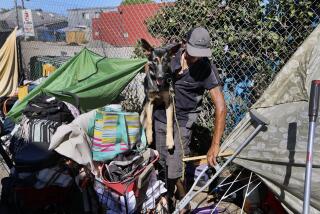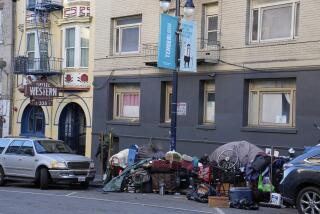Silicon Valley homeless no longer welcome in ‘the Jungle’
Reporting from SAN JOSE — Veiled by the yellow willows and brush along a forgotten creek bed in San Jose, hundreds of people jerry-built a treehouse and constructed underground bunkers and ramshackle lean-tos to form one of the nation’s largest homeless encampments.
The 68-acre shantytown is just minutes away from downtown and the high-tech giants that made Silicon Valley one of the world’s most opulent locations. For years, the city turned a blind eye to “the Jungle.” But the camp along the muddy bank of Coyote Creek has become more crowded in recent years and is awash in rotting trash, rats and human waste — so bad that the endangered steelhead trout have essentially disappeared.
After years of halfhearted cleanups, city officials on Thursday plan to begin shutting down the Jungle for good.
The sprawling camp has become a major embarrassment, and a potent emblem of Silicon Valley’s homeless crisis. In 2013, San Jose and the surrounding Santa Clara County estimated almost 7,600 homeless people, more than in San Francisco. And 75% of them were sleeping outside, on sidewalks, in parks and under freeway embankments — a percentage greater than in any other major U.S. metropolitan area.
Officials have blamed soaring housing costs for the displacement. As Silicon Valley rocketed out of the recession, workers streamed in, driving the average apartment rent within 10 miles of San Jose up to $2,633 in September, from $1,761 two years earlier, according to the rental website RentJungle.com.
The median home price is nearly $700,000.
“It’s a perfect storm of extreme wealth, a booming tech community and people priced out of the market,” said Jennifer Loving, executive director of Destination Home, a public-private partnership to end homelessness in the county.
Since deciding to close the Jungle, San Jose has spent $4 million over 18 months to relocate the camp’s inhabitants and connect them to services.
“The city really made a good-faith effort,” said Claire Wagner, communications director for HomeFirst, which runs a homeless shelter and services agency in San Jose.
But while 144 inhabitants have found housing, more than 50 have rent subsidies in hand but nowhere to go.
In 2011, the state ended special redevelopment assessments, which essentially brought affordable housing construction to a halt, said Ray Bramson, San Jose’s homelessness response manager. “Encampments are not the problem, homelessness is the problem,” Bramson said.
“If you have 10 applications to choose from, nine with stable rental histories and work, and you have somebody living in a creek; what are you going to do?” Loving added.
On Wednesday, some inhabitants of the Jungle were packing up to leave while others said they planned to remain as long as possible.
In heavy rain, Tiffany Curtis, 35, wearing a camouflage-colored jacket, hauled a shopping cart of her belongings — stuffed in garbage bags, a plastic crate and a Hello Kitty bag — to a waiting minivan.
The city is setting her up with a studio or one-bedroom unit that it has said would be paid for as long as she is working.
“It’s kind of good that they are closing this place down, because then people will have to find something to do,” Curtis said. “You can’t just sit or lay or smoke anywhere. The world doesn’t work like that.”
But Doug Wynne, 60, said he and his six cats intended to stay put as long as they could in his cozy complex of tents, sewn together with tarps, blankets and sleeping bags. During the four years he’s lived in the Jungle, he’s created a pathway of old bricks that lead to his front porch. His tent home is furnished with a rug, couch and beds.
“You can see, it’s much nicer than the dirt out there,” he said.
Wynne, a refugee from Florida’s foreclosure crisis, came to San Jose hoping to sell software, but ended up panhandling on the median of a busy roadway in the Little Saigon neighborhood.
“I’d sleep at the college, they’d bus me here.... Anywhere I went, [police] would harass me,” he said. “Once I came here, they stopped harassing me.”
Other homeless residents at the Jungle are working — doing manual labor, carpentry, catering. They return to the creek bed each night, unable to afford a better place, Bramson said.
Some have mental health or medical problems, criminal records or bad credit histories that are barriers to finding homes, he added.
Even without the Jungle, the city is veined by a network of at least 200 other outdoor encampments, Bramson said.
“If you accept the city has done great things to help a lot of people get housed, it’s a drop in the bucket,” said Matt King of Sacred Heart Community Service, a community organizing and poverty service group. “There is no margin of error in the Silicon Valley.
“If you don’t have nonstop good income, it’s a very fast fall from a two-bedroom apartment to a tent in the Jungle.”
Robert Aguirre’s path to the camp illustrates how tough it can be to maintain a middle-class toehold in the overheated economy.
A former engineering consultant, Aguirre, 56, advised high-tech companies on meeting international safety standards. When the first tech bubble burst in the late 1990s, his business began to slip. His job functions were largely outsourced to China, and he and his wife lost their house, he said.
Because of his wife’s health problems, including osteoarthritis, they gave up an upper-story apartment for a ground-floor unit. But after they gave notice, their new landlord told them he had changed his mind and planned to move in family members downstairs. Their old place already had been snapped up.
Sleeping sitting up in their car left his wife with edema, Aguirre said. On a doctor’s advice, they got a tent and moved to the Jungle in January.
Still, the couple says, they have it easy: Aguirre’s wife works as a medical clerk, and he picks up day-laborer jobs. They have a propane heater and stove and sleep on a platform mattress.
Aguirre said he had found a place to move into but planned to remain active with the Jungle community — whatever that becomes.
He estimated that 200 people remained in the creek bed camp as of late Tuesday.
“The fence links are so tight you can’t put bolt cutters to it,” Aguirre said, explaining that the city planned regular patrols by park rangers and police in order to prevent “re-encampment.”
“The majority of the people have said they don’t know what they’re going to do,” he said. “There is no way to get out of there other than to fend for themselves.”
[email protected]
Twitter: @ronlin
[email protected]
Twitter: @geholland
More to Read
Sign up for Essential California
The most important California stories and recommendations in your inbox every morning.
You may occasionally receive promotional content from the Los Angeles Times.












